The Impact of Brownfields on Residential Property Values in Post-Industrial Communities: A Study from the Eastern Part of the Czech Republic
Abstract
1. Introduction
2. Literature Review
2.1. Brownfields in Central Europe
2.2. Impact of Brownfields on the Value of Neighbouring Properties
3. Methods and Data
4. Results
4.1. Respondents’ Attitudes to the Impacts of Brownfields on the Value of Neighbouring Properties
4.2. Analysis of Real Estate Prices in the Context of the Localization of the Selected Brownfields
5. Discussion
6. Conclusions
Author Contributions
Funding
Institutional Review Board Statement
Informed Consent Statement
Data Availability Statement
Acknowledgments
Conflicts of Interest
Appendix A. Data
| Municipality/Questionnaire Response | Karviná | Orlová | Dětmarovice | Olomouc | Skrbeň | Stonava | Životice | Studénka | Bohumín | Zlín | Respondents | Mean | |
|---|---|---|---|---|---|---|---|---|---|---|---|---|---|
| Would you mind staying in the neighbourhood of an abandoned area (brownfield)?—YES | 84% | 73% | 72% | 67% | 70% | 74% | 94% | 88% | 65% | 63% | 852 | 74% | |
| Do you live approximately 500 m from an abandoned area (brownfield)?—YES | 78% | 89% | 30% | 42% | 85% | 48% | 75% | 100% | 56% | 40% | 743 | 64% | |
| Would you specifically purchase a property in close proximity to a brownfield if its price was about 20% lower than the usual price?—NO | 91% | 57% | 84% | 55% | 44% | 86% | 95% | 44% | 81% | 55% | 801 | 70% | |
| In general, you think that brownfields reduce the value of the surrounding properties? | yes, less than 10% | 13% | 36% | 28% | 27% | 34% | 32% | 3% | 38% | 44% | 52% | 367 | 32% |
| yes, between 10%–50% | 42% | 36% | 43% | 25% | 19% | 48% | 48% | 29% | 23% | 27% | 373 | 32% | |
| yes, more than 50 % | 44% | 11% | 13% | 26% | 22% | 14% | 46% | 25% | 11% | 7% | 252 | 22% | |
| No | 1% | 17% | 16% | 22% | 25% | 6% | 3% | 8% | 22% | 15% | 160 | 14% | |
| From what distance from brownfields would you be willing to buy a property? | 100–200 m | 8% | 16% | 19% | 17% | 14% | 14% | 8% | 36% | 18% | 29% | 205 | 17% |
| 200–500 m | 16% | 46% | 35% | 30% | 24% | 26% | 19% | 31% | 25% | 23% | 308 | 27% | |
| more than 500 m | 64% | 13% | 30% | 23% | 31% | 48% | 59% | 13% | 36% | 12% | 377 | 33% | |
| no, if I did not see brownfield | 5% | 15% | 6% | 22% | 19% | 12% | 11% | 18% | 14% | 19% | 164 | 14% | |
| no, without any conditions | 7% | 11% | 10% | 9% | 13% | 0% | 4% | 2% | 7% | 17% | 98 | 9% | |
| Determine the reasons why the proximity to brownfields negatively affects the value of real estate? | brownfield is usually dangerous from a construction and technical point of view | 61% | 46% | 60% | 47% | 36% | 68% | 70% | 41% | 37% | 72% | 538 | 47% |
| there is no certain future use of them | 45% | 37% | 47% | 36% | 9% | 56% | 36% | 42% | 47% | 33% | 388 | 34% | |
| brownfield is aesthetically unsightly | 38% | 36% | 29% | 30% | 20% | 12% | 32% | 56% | 50% | 11% | 313 | 27% | |
| brownfield is dangerous due to possible contamination and pollution that threatens health | 65% | 71% | 45% | 60% | 28% | 60% | 60% | 61% | 67% | 81% | 597 | 52% | |
| brownfield blocks development of the city | 44% | 25% | 34% | 26% | 8% | 16% | 28% | 12% | 69% | 8% | 269 | 23% | |
| social-pathological phenomena are concentrated in the brownfield | 94% | 88% | 69% | 85% | 58% | 88% | 89% | 79% | 88% | 91% | 829 | 72% | |
Appendix B
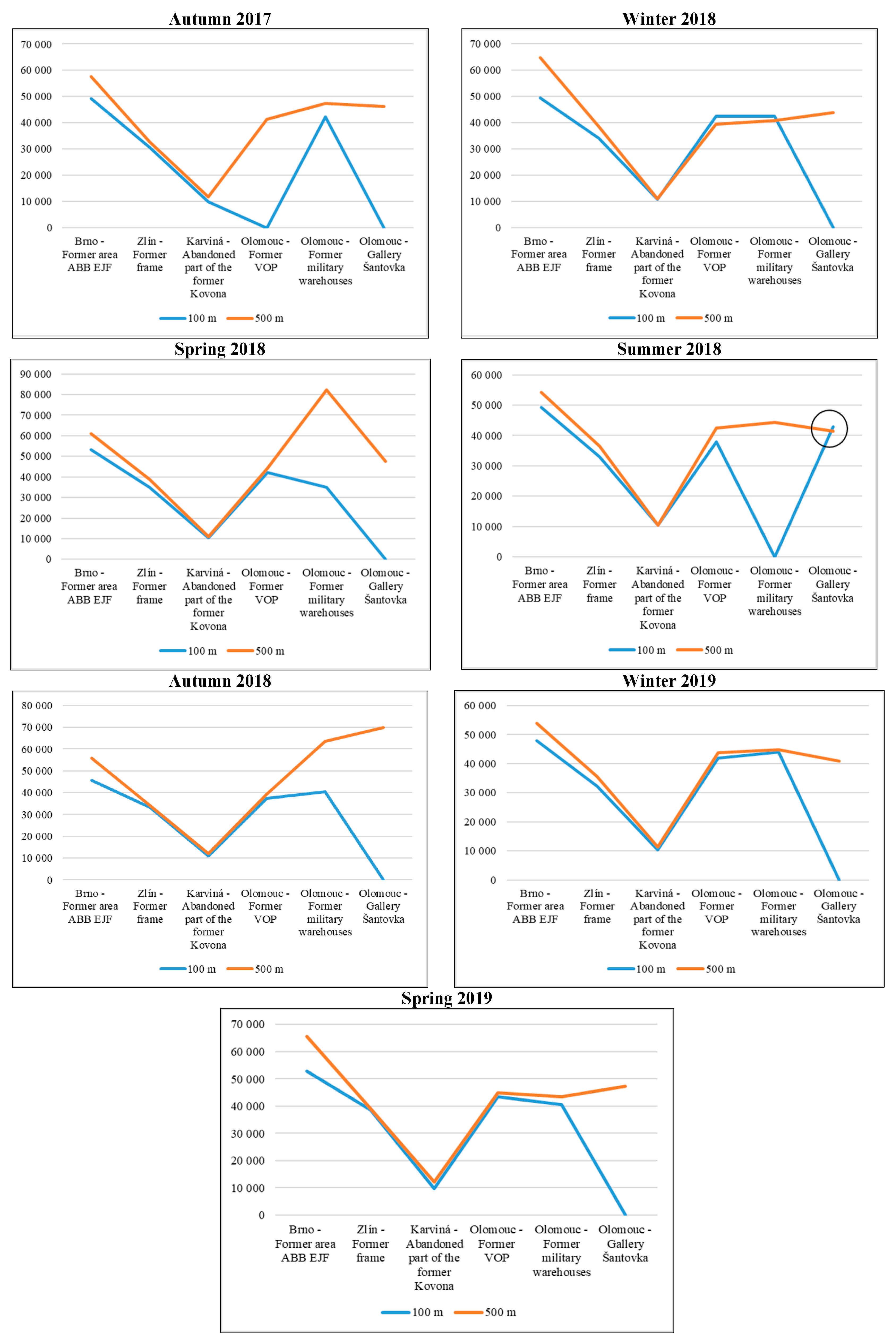
References
- Accordino, J.; Johnson, G.T. Addressing the Vacant and Abandoned Property Problem. J. Urban Aff. 2000, 22, 301–315. [Google Scholar] [CrossRef]
- Yount, K.R. What Are Brownfields? Finding a Conceptual Definition. Environ. Pract. 2003, 5, 25–33. [Google Scholar] [CrossRef]
- Krzysztofik, R.; Kantor-Pietraga, I.; Spórna, T. A Dynamic Approach to the Typology of Functional Derelict Areas (Sosnowiec, Poland). Morav. Geogr. Rep. 2013, 20, 39–54. [Google Scholar] [CrossRef][Green Version]
- Turečková, K.; Nevima, J.; Škrabal, J.; Tuleja, P. Categorization of Impact of the Selected Variables for Potential Brownfield Regeneration in the Czech Republic by Means of Correspondence Analysis. Geogr. Tech. 2019, 14, 120–130. [Google Scholar] [CrossRef]
- Klusáček, P.; Navrátil, J.; Martinát, S.; Krejčí, T.; Golubchikov, O.; Pícha, K.; Škrabal, J.; Osman, R. Planning for the future of derelict farm premises: From abandonment to regeneration? Land Use Policy 2021, 102, 105248. [Google Scholar] [CrossRef]
- Cocheci, R.-M.; Ianoş, I.; Sârbu, C.N.; Sorensen, A.; Saghin, I.; Secăreanu, G. Assessing environmental fragility in a mining area for specific spatial planning purposes. Morav. Geogr. Rep. 2019, 27, 169–182. [Google Scholar] [CrossRef]
- Navratil, J.; Picha, K.; Martinat, S.; Nathanail, P.C.; Tureckova, K.; Holesinska, A. Resident’s preferences for urban brownfield revitalization: Insights from two Czech cities. Land Use Policy 2018, 76, 224–234. [Google Scholar] [CrossRef]
- De Sousa, C.A.; Wu, C.; Westphal, L.M. Assessing the Effect of Publicly Assisted Brownfield Redevelopment on Surrounding Property Values. Econ. Dev. Q. 2009, 23, 95–110. [Google Scholar] [CrossRef]
- Wang, N.; Golubchikov, O.; Chen, W.; Liu, Z. The Hybrid Spatialities of Post-Industrial Beijing: Communism, Neoliberalism, and Brownfield Redevelopment. Sustainability 2020, 12, 5029. [Google Scholar] [CrossRef]
- Zhao, Q.; Xu, Q.; Liu, M. Case Study: Brownfield Externalities’ Valuation in Wuhan, China. J. Sustain. Real Estate 2018, 10, 59–80. [Google Scholar] [CrossRef]
- Turečková, K.; Martinát, S.; Škrabal, J.; Chmielová, P.; Nevima, J. How local Population Perceive Impact of Brownfields on the Residential Property Values: Some Remarks from Post-Industrial Areas in the Czech Republic. Geogr. Tech. 2017, 12, 150–164. [Google Scholar] [CrossRef][Green Version]
- Osman, R.; Frantál, B.; Klusáček, P.; Kunc, J.; Martinát, S. Factors affecting brownfield regeneration in post-socialist space: The case of the Czech Republic. Land Use Policy 2015, 48, 309–316. [Google Scholar] [CrossRef]
- Sucháček, J.; Seďa, P.; Friedrich, V.; Koutský, J. Regional aspects of the development of largest enterprises in the Czech Republic. Technol. Econ. Dev. Econ. 2017, 23, 649–666. [Google Scholar] [CrossRef]
- Kunc, J.; Martinat, S.; Tonev, P.; Frantal, B. Destiny of urban brownfields: Spatial patterns and perceived censequences of post-socialistic deindustrialization. Transylv. Rev. Adm. Sci. 2014, 10, 109–128. [Google Scholar]
- Navrátil, J.; Martinát, S.; Krejčí, T.; Pícha, K.; Klusáček, P.; Škrabal, J.; Osman, R. The fate of socialist agricultural premises: To agricultural “brownfields” and back again? Morav. Geogr. Rep. 2019, 27, 207–216. [Google Scholar] [CrossRef]
- Borseková, K.; Cole, D.; Petríková, K.; Vaňová, A. Nostalgic Sentiment And Cultural And Creative Industries In Regional Development: A Slovak Case Study. Quaest. Geogr. 2015, 34, 53–63. [Google Scholar] [CrossRef]
- Krzysztofik, R.; Dulias, R.; Kantor-Pietraga, I.; Spórna, T.; Dragan, W. Paths of urban planning in a post-mining area. A case study of a former sandpit in southern Poland. Land Use Policy 2020, 99, 104801. [Google Scholar] [CrossRef]
- Greenberg, M.; Lowrie, K.; Solitare, L.; Duncan, L. Brownfields, Toads, and the Struggle for Neighborhood Redevelopment. Urban Aff. Rev. 2000, 35, 717–733. [Google Scholar] [CrossRef]
- Dennison, S.M. Brownfields Redevelopment; Government Institutes: Rockville, MD, USA, 1998. [Google Scholar]
- Turečková, K.; Varadzin, F.; Nevima, J. Public Administration and Problematics of Brownfield in the Czech Republic. In Public Administration 2018: Proceedings of the 12th International Scientific Conference, 24 May 2018; University of Pardubice: Pardubice, Czech Republic, 2018; pp. 205–215. [Google Scholar]
- Vaňová, A.; Vitálišová, K.; Borseková, K. Place Marketing; Belianum: Banská Bystrica, Slovakia, 2017. [Google Scholar]
- Bole, D.; Kozina, J.; Tiran, J. The socioeconomic performance of small and mediumsized industrial towns: Slovenian perspectives. Morav. Geogr. Rep. 2020, 28, 16–28. [Google Scholar] [CrossRef]
- Bromberg, L.M.; Spiesman, T. Turning an economic liability into an asset: The anatomy of a redevelopment project. New Jersey Law J. 2006, 184, 1–4. [Google Scholar]
- De Sousa, C. Brownfield Redevelopment versus Greenfield Development: A Private Sector Perspective on the Costs and Risks Associated with Brownfield Redevelopment in the Greater Toronto Area. J. Environ. Plan. Manag. 2000, 43, 831–853. [Google Scholar] [CrossRef]
- Kaufman, D.A.; Cloutier, N.R. The Impact of Small Brownfields and Greenspaces on Residential Property Values. J. Real Estate Financ. Econ. 2006, 33, 19–30. [Google Scholar] [CrossRef]
- Mihaescu, O.; vom Hofe, R. The impact of brownfields on residential property values in Cincinnati, Ohio: A spatial hedonic approach. J. Reg. Anal. Policy 2012, 42, 223–236. [Google Scholar]
- Sun, W.; Jones, B. Using Multi-Scale Spatial and Statistical Analysis to Assess the Effects of Brownfield Redevelopment on Surrounding Residential Property Values in Milwaukee County, USA. Morav. Geogr. Rep. 2013, 21, 56–64. [Google Scholar] [CrossRef][Green Version]
- Gibilaro, L.; Mattarocci, G. Brownfield Areas and Housing Value: Evidence from Milan. J. Sustain. Real Estate 2019, 11, 60–83. [Google Scholar] [CrossRef][Green Version]
- Keenan, P.; Lowe, S.; Spencer, S. Housing Abandonment in Inner Cities-The Politics of Low Demand for Housing. Hous. Stud. 1999, 14, 703–716. [Google Scholar] [CrossRef]
- Haninger, K.; Ma, L.; Timmins, C. Estimating the Impacts of Brownfield Remediation on Housing Property Values. Duke Environmental and Energy Economics Working Paper Series. 2012. Available online: https://papers.ssrn.com/sol3/papers.cfm?abstract_id=2469241 (accessed on 20 February 2022).
- Evans, P. The Environmental and Economic Impacts of Brownfields Redevelopment. 2008. Available online: http://www.nemw.org/wp-content/uploads/2015/06/2008-Environ-Econ-Impacts-Brownfield-Redev.pdf (accessed on 10 November 2021).
- Haninger, K.; Ma, L.; Timmins, C. The Value of Brownfield Remediation. J. Assoc. Environ. Resour. Econ. 2017, 4, 197–241. [Google Scholar] [CrossRef]
- Ihlanfeldt, K.R.; Taylor, L.O. Externality effects of small-scale hazardous waste sites: Evidence from urban commercial property markets. J. Environ. Econ. Manag. 2004, 47, 117–139. [Google Scholar] [CrossRef]
- Linn, J. The effect of voluntary brownfields programs on nearby property values: Evidence from Illinois. J. Urban Econ. 2013, 78, 1–18. [Google Scholar] [CrossRef]
- Savchenko, O.; Braden, J.B. Economic Value of Sustainable Brownfield Redevelopment; Working Paper; University of Illinois: Champaign, IL, USA, 2014. [Google Scholar]
- USEPA. The EPA Brownfields Program Produces Widespread Environmental and Economic Benefits. 2015. Available online: https://www.epa.gov/sites/production/files/2015-09/documents/brownfields-benefits-postcard.pdf (accessed on 10 December 2021).
- Turečková, K.; Nevima, J. The Cost Benefit Analysis for the Concept of a Smart City: How to Measure the Efficiency of Smart Solutions? Sustainability 2020, 12, 2663. [Google Scholar] [CrossRef]
- Banzhaf, H.S.; McCormick, E. Moving Beyond Cleanup: Identifying the Crucibles of Environmental Gentrification; Report Prepared for the National Center for Environmental Economics (EPA); 2006. Available online: https://www.epa.gov/sites/default/files/2014-12/documents/moving_beyond_cleanup_identifying_the_crucibles_of_environmental_gentrification.pdf (accessed on 4 January 2022).
- Hesse, M. Land for logistics: Locational dynamics, real estate markets and political regulation of regional distribution complexes. Tijdschr. Voor Econ. En Soc. Geogr. 2004, 95, 162–173. [Google Scholar] [CrossRef]
- Immergluck, D.; Smith, G. Measuring the Effect of Subprime Lending on Neighborhood Foreclosures. Urban Aff. Rev. 2005, 40, 362–389. [Google Scholar] [CrossRef]
- Munroe, D.K. Exploring the Determinants of Spatial Pattern in Residential Land Markets: Amenities and Disamenities in Charlotte, NC, USA. Environ. Plan. B Plan. Des. 2007, 34, 336–354. [Google Scholar] [CrossRef]
- Baxter, V.; Lauria, M. Residential mortgage foreclosure and neighborhood change. Hous. Policy Debate 2000, 11, 675–699. [Google Scholar] [CrossRef]
- Coffin, S.L. Closing the Brownfield Information Gap: Some Practical Methods for Identifying Brownfields. Environ. Pract. 2003, 5, 34–39. [Google Scholar] [CrossRef]
- Trouw, M.; Weiler, S.; Silverstein, J. Brownfield Development: Uncertainty, Asymmetric Information, and Risk Premia. Sustainability 2020, 12, 2046. [Google Scholar] [CrossRef]
- Chen, I.-C.; Chuo, Y.-Y.; Ma, H. Uncertainty analysis of remediation cost and damaged land value for brownfield investment. Chemosphere 2019, 220, 371–380. [Google Scholar] [CrossRef]
- Mccann, P. Modern Urban and Regional Economics; Oxford University Press: Oxford, UK, 2013. [Google Scholar]
- Can, A. Specification and estimation of hedonic housing price models. Reg. Sci. Urban Econ. 1992, 22, 453–474. [Google Scholar] [CrossRef]
- Brown, L.R. World on the Edge: How to Prevent Environmental and Economic Collapse; Routledge: New York, NY, USA, 2012. [Google Scholar]
- Bartke, S.; Schwarze, R. No perfect tools: Trade-offs of sustainability principles and user requirements in designing support tools for land-use decisions between greenfields and brownfields. J. Environ. Manag. 2015, 153, 11–24. [Google Scholar] [CrossRef]
- Frantál, B.; Greer-Wootten, B.; Klusáček, P.; Krejčí, T.; Kunc, J.; Martinát, S. Exploring spatial patterns of urban brownfields regeneration: The case of Brno, Czech Republic. Cities 2015, 44, 9–18. [Google Scholar] [CrossRef]
- Duda, D.; Turečková, K. The issue of brownfields and their tools to support solutions in the public sector: A case study of the Czech Republic. In Mezinárodní Vztahy 2019: Aktuální Otázky Světové Ekonomiky a Politiky; EUBA: Bratislava, Slovakia, 2019; pp. 204–222. [Google Scholar]
- Tedd, P.; Charles, J.A.; Driscoll, R. Sustainable brownfield re-development—Risk management. Eng. Geol. 2001, 60, 333–339. [Google Scholar] [CrossRef]
- Hollander, J.B.; Kirkwood, N.G.; Gold, J.L. Principles of Brownfield Regeneration: Cleanup, Design, and Reuse of Derelict Land; Island Press: Boston, MA, USA, 2010. [Google Scholar]
- Jackson, J. Urban Sprawl. Urban A Územní Rozv. 2002, 5, 21–28. [Google Scholar]
- Raco, M.; Henderson, S. Sustainable urban planning and the brownfield development process in the United Kingdom: Lessons from the Thames Gateway. Local Environ. 2006, 11, 499–513. [Google Scholar] [CrossRef]
- Dixon, T.; Adams, D. Housing Supply and Brownfield Regeneration in a post-Barker World: Is There Enough Brownfield Land in England and Scotland? Urban Stud. 2008, 45, 115–139. [Google Scholar] [CrossRef]
- Melecký, L.; Staníčková, M. Cost Efficiency of EU Funded Projects: Case of Selected SMEs in the Moravian-Silesian Region. In Proceedings of the 12th International Conference on Strategic Management and its Support by Information Systems (SMSIS), Ostrava, Czech Republic, 25–26 May 2017; VSB-Technical University Ostrava: Ostrava, Czech Republic, 2017; pp. 293–303. [Google Scholar]
- Bowes, D.R.; Ihlanfeldt, K.R. Identifying the Impacts of Rail Transit Stations on Residential Property Values. J. Urban Econ. 2001, 50, 1–25. [Google Scholar] [CrossRef]
- Gogtay, N.J.; Thatte, U.M. Principles of correlation analysis. J. Assoc. Physicians India 2017, 65, 78–81. [Google Scholar]
- Turečková, K.; Chmielová, P. Brownfieldy v regionálním rozvoji a v externalitní teorii. In XXI. Mezinárodní Kolokvium o Regionálních Vědách; MU ESF Brno: Brno, Czech Republic, 2018; pp. 302–308. [Google Scholar]
- Tagai, G. The Territorial Dimension of Social Exclusion in East-Central-Europe. Deturope-Cent. Eur. J. Tour. Reg. Dev. 2016, 8, 58–71. [Google Scholar] [CrossRef]
- Bond, S.; Cook, D. Residents’ Perceptions Towards Asbestos Contamination of Land and It’s Impact on Residential Property Values. Pac. Rim Prop. Res. J. 2004, 10, 328–352. [Google Scholar] [CrossRef]
- Leigh, N.G.; Coffin, S.L. Modeling the relationship among brownfields, property values, and community revitalization. Hous. Policy Debate 2005, 16, 257–280. [Google Scholar] [CrossRef]
- Watkins, S. The Impact of Brownfield Reclamation on Surrounding Land Values and Crime. 2010, p. 12. Available online: https://gis.smumn.edu/GradProjects/WatkinsS.pdf (accessed on 12 January 2022).
- Thornton, G.; Franz, M.; Edwards, D.; Pahlen, G.; Nathanail, P. The challenge of sustainability: Incentives for brownfield regeneration in Europe. Environ. Sci. Policy 2007, 10, 116–134. [Google Scholar] [CrossRef]
- Zitti, M.; Efstathios, G.; Salvati, L. Beyond the ‘Divided City’: A manifesto for spatially-balanced, sprawl-free post-crisis metropolises. Rev. Appl. Socio-Econ. Res. 2017, 13, 95–109. [Google Scholar]
- Ganser, R.; Williams, K. Brownfield Development: Are We Using the Right Targets? Evidence from England and Germany. Eur. Plan. Stud. 2007, 15, 603–622. [Google Scholar] [CrossRef]
- Pacione, M. Urban Geography A Global Perspective; Routledge: New York, NY, USA, 2009. [Google Scholar]
- Adams, D.; De Sousa, C.; Tiesdell, S. Brownfield Development: A Comparison of North American and British Approaches. Urban Stud. 2010, 47, 75–104. [Google Scholar] [CrossRef]
- Pediaditi, K.; Doick, K.J.; Moffat, A.J. Monitoring and evaluation practice for brownfield, regeneration to greenspace initiatives. Landsc. Urban Plan. 2010, 97, 22–36. [Google Scholar] [CrossRef]
- Schädler, S.; Morio, M.; Bartke, S.; Rohr-Zänker, R.; Finkel, M. Designing sustainable and economically attractive brownfield revitalization options using an integrated assessment model. J. Environ. Manag. 2011, 92, 827–837. [Google Scholar] [CrossRef]
- Szczepańska, M.; Kacprzak, E.; Maćkiewicz, B.; Poniży, L. How are allotment gardens managed? A comparative study of usage and development in contemporary urban space in Germany and Poland. Morav. Geogr. Rep. 2021, 29, 231–250. [Google Scholar] [CrossRef]
- Klusáček, P.; Navrátil, J.; Martinát, S.; Charvátová, K.; Krejčí, T. From large-scale communist agricultural premise through abandoned contaminated ruin to organic farming production: The story of successful post-agricultural brownfield regeneration. Deturope-Cent. Eur. J. Tour. Reg. Dev. 2021, 13, 32–57. [Google Scholar] [CrossRef]
- Horeczki, R.; Egyed, I. Small town development in peripheral areas. Deturope-Cent. Eur. J. Tour. Reg. Dev. 2021, 13, 52–65. [Google Scholar] [CrossRef]

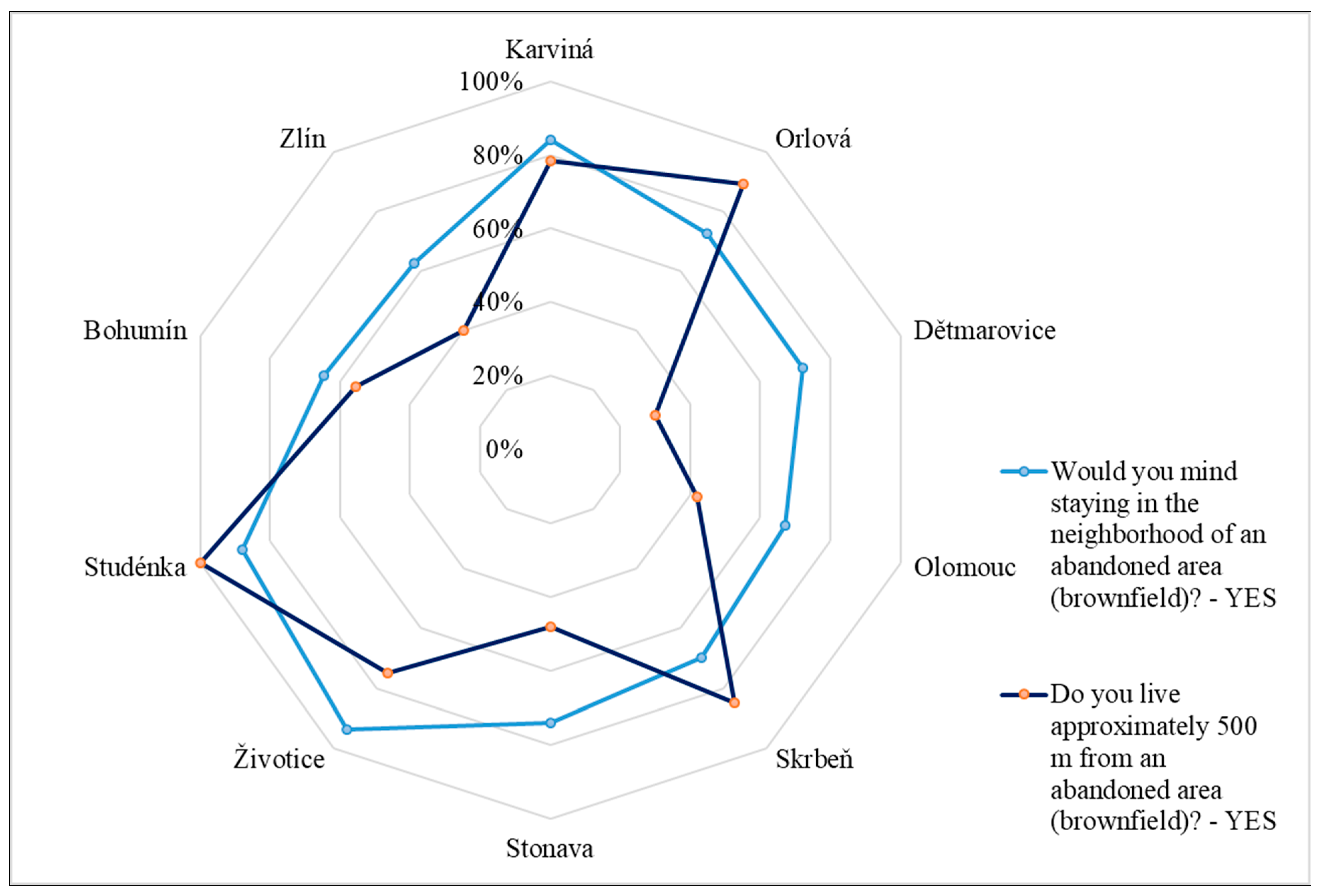
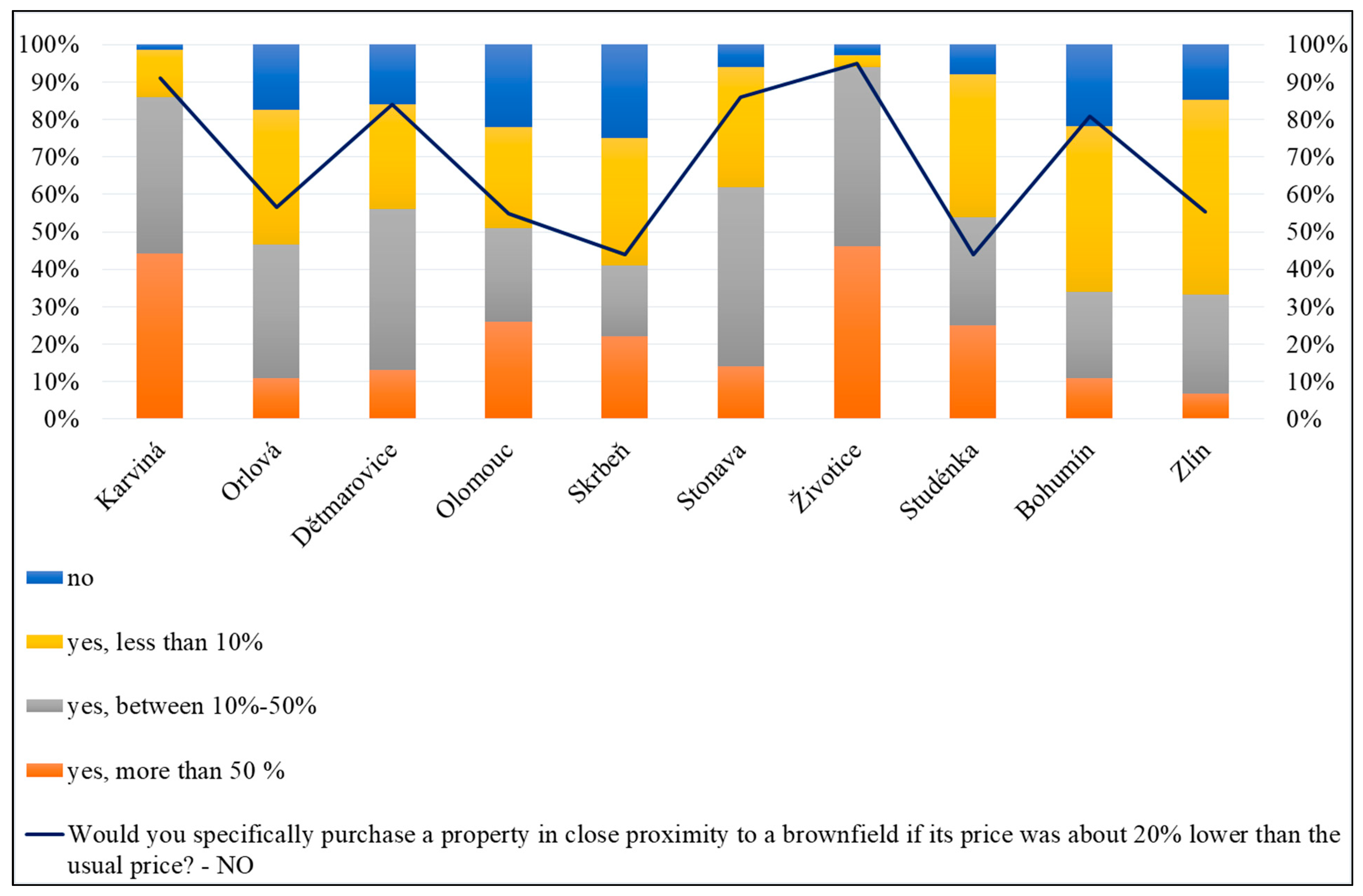
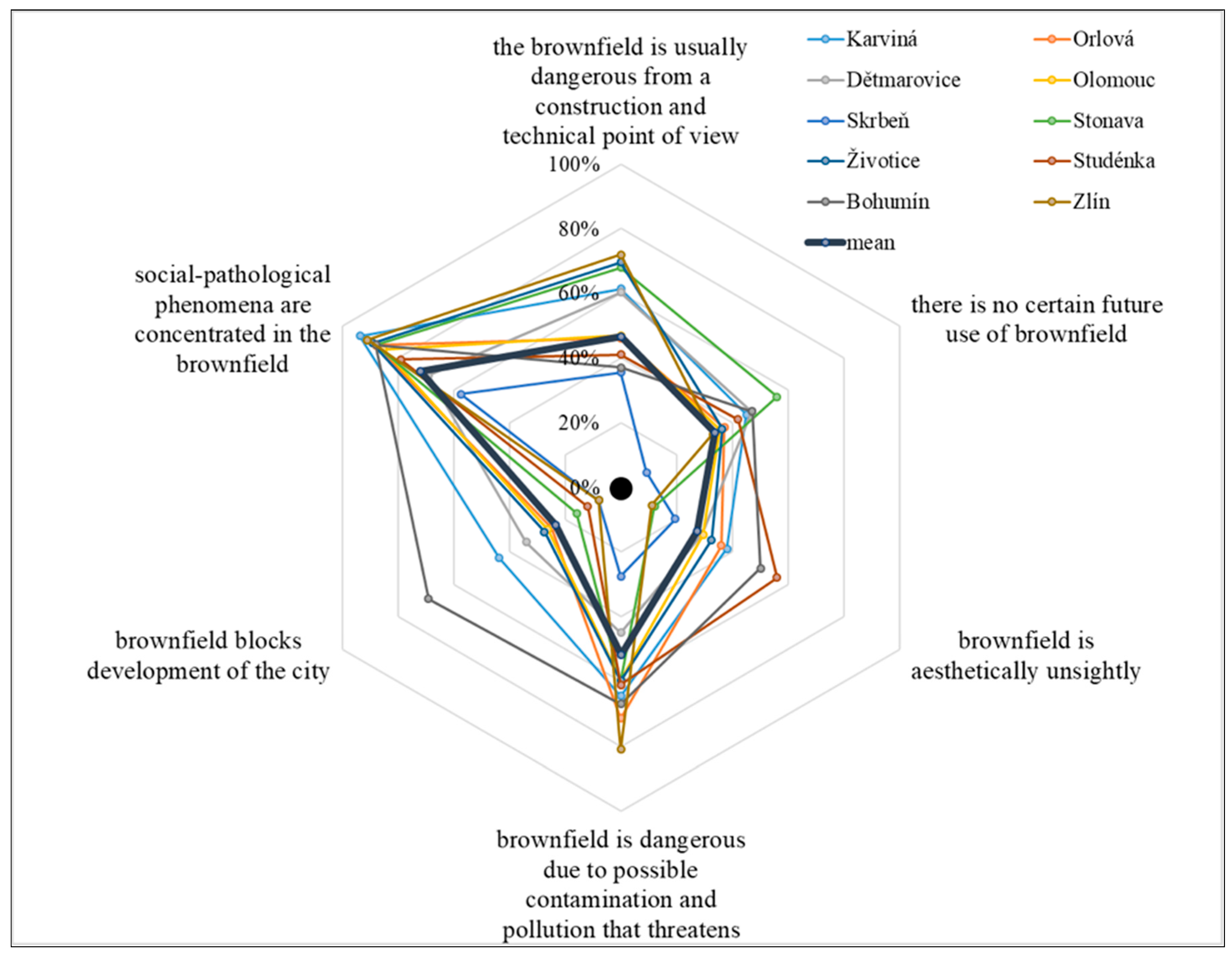
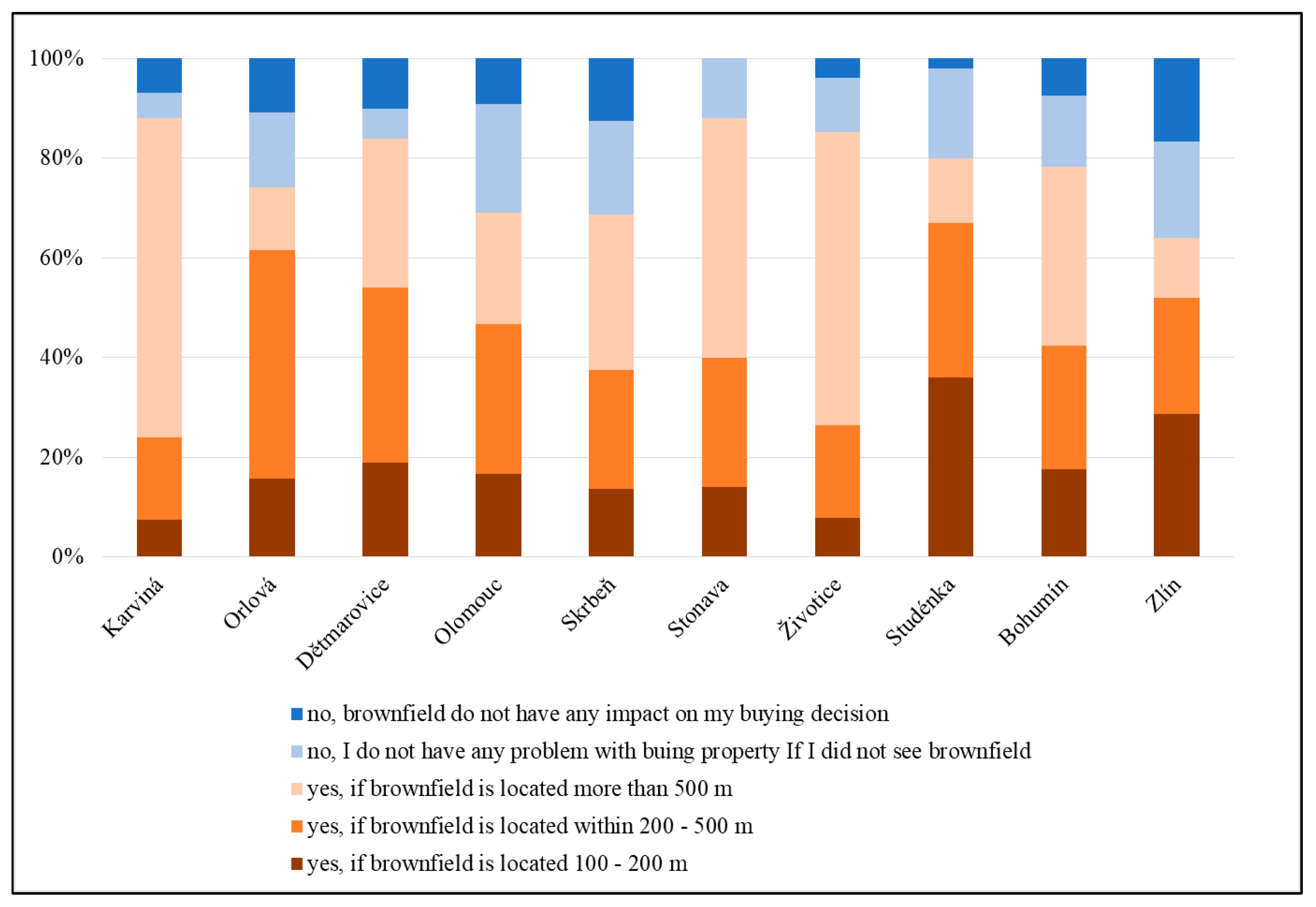
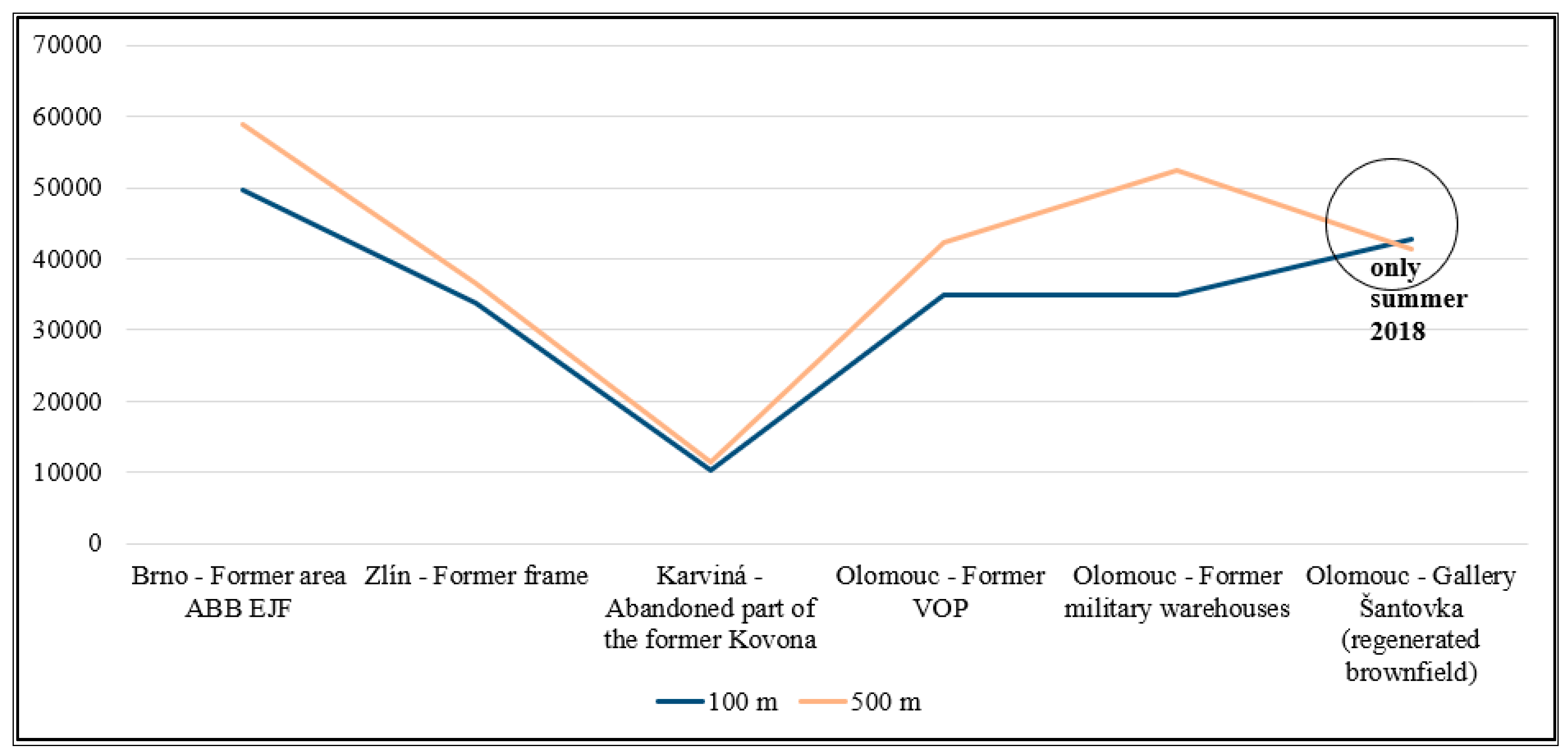
| Variable/Municipality/Number of Questionnaires | Karviná | Orlová | Dětmarovice | Olomouc | Skrbeň | Stonava | Životice | Studénka | Bohumín | Zlín | Total | ||
|---|---|---|---|---|---|---|---|---|---|---|---|---|---|
| 158 | 120 | 69 | 120 | 80 | 50 | 102 | 100 | 203 | 150 | 1152 | 100% | ||
| Gender | Female | 80 | 46 | 42 | 49 | 35 | 22 | 40 | 44 | 93 | 71 | 522 | 45% |
| Male | 78 | 74 | 27 | 71 | 45 | 28 | 62 | 56 | 110 | 79 | 630 | 55% | |
| Age | 18–25 years | 24 | 16 | 15 | 38 | 40 | 4 | 6 | 21 | 28 | 40 | 232 | 20% |
| 26–45 years | 72 | 61 | 33 | 47 | 25 | 19 | 57 | 41 | 100 | 72 | 527 | 46% | |
| 46–65 years | 52 | 36 | 17 | 25 | 15 | 17 | 26 | 22 | 62 | 26 | 298 | 26% | |
| 65 and over | 10 | 7 | 4 | 10 | 0 | 10 | 13 | 16 | 13 | 12 | 95 | 8% | |
| Education | Elementary | 7 | 8 | 5 | 14 | 5 | 3 | 11 | 14 | 23 | 0 | 90 | 8% |
| Secondary without final exam | 38 | 20 | 16 | 42 | 14 | 19 | 29 | 25 | 49 | 15 | 267 | 23% | |
| Secondary with final exam | 89 | 68 | 36 | 44 | 55 | 25 | 47 | 43 | 116 | 88 | 611 | 53% | |
| Tertiary | 24 | 24 | 12 | 19 | 6 | 3 | 15 | 18 | 15 | 47 | 184 | 16% | |
| Social status | Employees | 95 | 63 | 41 | 52 | 40 | 24 | 26 | 52 | 124 | 76 | 593 | 51% |
| Students | 14 | 10 | 9 | 31 | 25 | 4 | 20 | 10 | 34 | 52 | 209 | 18% | |
| Entrepreneurs | 19 | 6 | 7 | 5 | 0 | 3 | 24 | 7 | 17 | 14 | 102 | 9% | |
| Unemployed | 4 | 9 | 1 | 5 | 0 | 0 | 9 | 8 | 0 | 3 | 39 | 3% | |
| Retired persons | 19 | 22 | 7 | 11 | 0 | 15 | 15 | 15 | 19 | 0 | 123 | 11% | |
| Persons on maternal/parental leave | 7 | 10 | 4 | 17 | 15 | 4 | 8 | 8 | 9 | 5 | 87 | 8% | |
| Municipality/Characteristics of Brownfield | Brownfield | Area [m2] | Ownership | Previous Use |
|---|---|---|---|---|
| Brno | Former area of ABB factory | 52,700 | Private | Industrial |
| Zlín | Unfinished shopping centre | 53,200 | Public | Civic amenities |
| Karviná | Abandoned part of the former Kovona | 122,000 | Private | Industrial |
| Olomouc | Former military repair factory | 125,000 | Private | Military |
| Olomouc | Former military warehouse | 170,000 | Private | Military |
| Olomouc | Former food factory Milo (Šantovka) | 24,000 | Private | Industrial |
| Statement no 1 | Inhabitants who live in the proximity to brownfields and realise their negative impact on neighbouring real estate. | 0.8470 |
| Statement no 2 | Inhabitants who live in proximity to brownfields and are bothered by this fact. | 0.7626 |
| Statement no 3 | Inhabitants who considered proximity to brownfield when purchasing their real estate (if the price was lower by 20%). | 0.9473 |
| Statement no 4 | Inhabitants would be bothered by living in the brownfield neighbourhood. The occurrence of brownfields would be a factor when thinking about purchasing real estate. | 0.9622 |
| Statement no 5 | Inhabitants younger than 65 years are the most bothered by living in proximity to brownfields, and at the same time, they acknowledge the negative impact of brownfields on neighbouring real estate. | 0.9395 |
| Time Period/Distance/Brownfield | Autumn 2017 | Winter 2018 | Spring 2018 | Summer 2018 | ||||
| 100 m | 500 m | 100 m | 500 m | 100 m | 500 m | 100 m | 500 m | |
| Brno—Former area ABB EJF | 49,286 | 57,646 | 49,265 | 64,726 | 53,359 | 60,925 | 49,276 | 54,198 |
| Zlín—Former unfinished shopping mall | 30,665 | 32,716 | 34,033 | 38,455 | 34,872 | 38,917 | 32,926 | 36,407 |
| Karviná—Abandoned part of the former Kovona | 9836 | 11,834 | 10,841 | 10,946 | 10,298 | 11,069 | 10,384 | 10,540 |
| Olomouc—Former VOP | - | 41,314 | 42,412 | 39,372 | 42,087 | 44,312 | 37,856 | 42,502 |
| Olomouc—Former military warehouses | 42,224 | 47,333 | 42,421 | 40,648 | 34,833 | 82,353 | - | 44,296 |
| Olomouc—Gallery Šantovka (regenerated brownfield) | - | 46,244 | - | 43,695 | - | 47,679 | 42,793 | 41,350 |
| Time period/distance/brownfield | Autumn 2018 | Winter 2019 | Spring 2019 | Mean | ||||
| 100 m | 500 m | 100 m | 100 m | 500 m | 100 m | 500 m | 100 m | |
| Brno—Former area ABB EJF | 45,640 | 55,950 | 47,980 | 53,898 | 52,912 | 65,533 | 49,674 | 58,982 |
| Zlín—Former frame | 33,276 | 34,139 | 32,191 | 35,483 | 38,655 | 39,184 | 33,803 | 36,472 |
| Karviná—Abandoned part of the former Kovona | 10,953 | 12,215 | 10,238 | 11,389 | 9653 | 12,247 | 10,315 | 11,463 |
| Olomouc—Former VOP | 37,414 | 39,251 | 41,860 | 43,695 | 43,526 | 44,961 | 35,022 | 42,201 |
| Olomouc—Former military warehouses | 40,323 | 63,415 | 43,899 | 44,839 | 40,684 | 43,476 | 34,912 | 52,337 |
| Olomouc—Gallery Šantovka (regenerated brownfield) | - | 69,966 | - | 40,954 | - | 47,290 | 42,793 | 41,350 |
Publisher’s Note: MDPI stays neutral with regard to jurisdictional claims in published maps and institutional affiliations. |
© 2022 by the authors. Licensee MDPI, Basel, Switzerland. This article is an open access article distributed under the terms and conditions of the Creative Commons Attribution (CC BY) license (https://creativecommons.org/licenses/by/4.0/).
Share and Cite
Turečková, K.; Martinát, S.; Nevima, J.; Varadzin, F. The Impact of Brownfields on Residential Property Values in Post-Industrial Communities: A Study from the Eastern Part of the Czech Republic. Land 2022, 11, 804. https://doi.org/10.3390/land11060804
Turečková K, Martinát S, Nevima J, Varadzin F. The Impact of Brownfields on Residential Property Values in Post-Industrial Communities: A Study from the Eastern Part of the Czech Republic. Land. 2022; 11(6):804. https://doi.org/10.3390/land11060804
Chicago/Turabian StyleTurečková, Kamila, Stanislav Martinát, Jan Nevima, and František Varadzin. 2022. "The Impact of Brownfields on Residential Property Values in Post-Industrial Communities: A Study from the Eastern Part of the Czech Republic" Land 11, no. 6: 804. https://doi.org/10.3390/land11060804
APA StyleTurečková, K., Martinát, S., Nevima, J., & Varadzin, F. (2022). The Impact of Brownfields on Residential Property Values in Post-Industrial Communities: A Study from the Eastern Part of the Czech Republic. Land, 11(6), 804. https://doi.org/10.3390/land11060804








